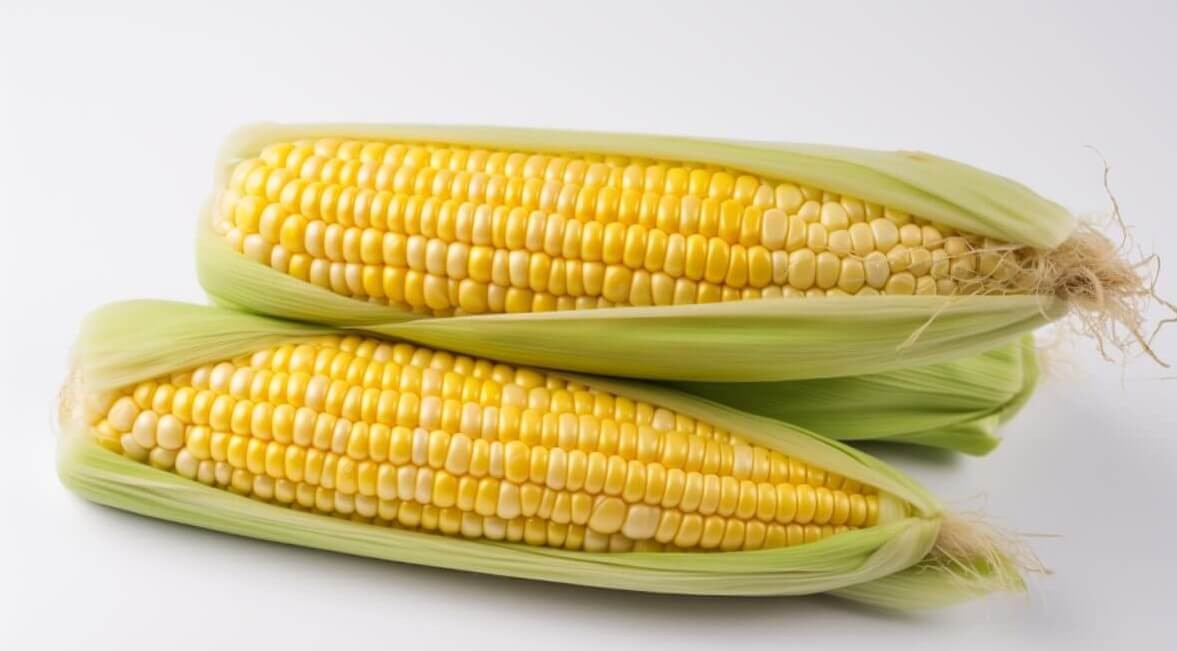Would you prefer to listen to a short podcast discussion about this article? Click on the audio below.
Sweetcorn, or ‘corn on the cob’ as it is commonly known, is a delicious and versatile crop that can be grown successfully in the UK. If you’re looking to start growing your own sweetcorn, there are a few key things you need to know. In this article, we’ll cover everything from preparing the soil to harvesting and storing your crop, so read on to learn how to grow sweetcorn in the UK.
Table of Contents
Preparing the Soil for Sweetcorn Planting
Before you start planting your seeds, it’s important to prepare the soil properly to ensure the best possible growing conditions. Sweetcorn is a warm-season crop that thrives in full sun and well-drained soil. It requires soil that is rich in organic matter, with a pH level that falls within the optimal range of 6.0 to 6.8.
If you’re planting in a new garden bed, it’s a good idea to start preparing the soil in the fall. This will give the soil plenty of time to settle and the organic matter to break down, creating a nutrient-rich environment for your plants to grow in.
One of the first steps in preparing the soil is to remove any weeds or debris from the planting area. This will help prevent competition for nutrients and water. Once the area is clear, spread a layer of compost or well-rotted manure over the soil and work it in deeply with a garden fork or tiller.
If your soil is heavy or especially compact, you may want to add sand or vermiculite to improve drainage. This will help prevent water from pooling around the roots of your sweetcorn plants, which can lead to root rot and other problems.
It’s also important to test your soil’s pH level to ensure it falls within the optimal range for your plants. You can purchase a soil testing kit at your local garden centre or online. If the pH is too low, you can add lime to raise it; if it’s too high, you can add sulfur to lower it.
Once you’ve prepared the soil, rake it smooth and level it off before planting. This will help ensure that your seeds are planted at a consistent depth and will have an even start to their growth.
By taking the time to properly prepare your soil for planting, you’ll be setting your plants up for success and ensuring a bountiful harvest of delicious, sweet corn.
Choosing the Right Variety for UK Conditions
When it comes to growing corn on the cob, there are a few things to consider before choosing the right variety. The UK has a relatively cool and damp climate, which means that some varieties may not thrive as well as others. It’s important to choose a variety that is suited to these conditions to ensure a successful harvest.
One popular variety that is well-suited to UK conditions is ‘Swift’. This variety is an early-ripening variety that can be harvested in late summer. It produces cobs that are around 20cm in length, with sweet and tender kernels that are perfect for roasting or boiling. Another great option for UK conditions is the ‘Lark’ sweetcorn. This variety is also early-ripening, with cobs that are slightly smaller than the ‘Swift’ variety. However, it is known for its excellent flavour and texture, making it a popular choice for many gardeners.
When selecting a variety, it’s also important to consider the type of corn it produces. There are three main types: normal sugary (su), sugar enhanced (se), and supersweet (sh2). Normal sugary varieties are the oldest and most easily grown, but they tend to have the shortest shelf life. Sugar-enhanced and supersweet varieties are more disease-resistant and have a longer shelf life, but they may require more careful cultivation.
If you’re looking for a variety with a longer shelf life, ‘Temptation’ is a great option. This variety is a sugar-enhanced variety that produces cobs with a high sugar content, making them perfect for freezing or canning. It’s also known for its disease resistance, making it a low-maintenance option for the home gardener.
For those who prefer a sweeter variety, ‘Incredible’ is a supersweet variety that is sure to please. This variety produces cobs with high sugar content and a crisp, juicy texture. However, it’s important to note that supersweet varieties can be more difficult to grow and may require more careful cultivation.
Overall, when selecting a variety for UK conditions, it’s important to consider factors such as ripening time, flavour, and disease resistance. By choosing the right variety, you can ensure a successful harvest and delicious corn on the cob for your table.

Planting at the Right Time
Sweetcorn is a delicious and versatile vegetable that can be enjoyed in a variety of dishes. Planting your crop at the right time is crucial for a successful and bountiful harvest. Here are some additional tips to help you grow sweetcorn:
Before planting, it’s important to prepare the soil properly. Corn on the cob thrives in well-draining soil that is rich in organic matter. You can add compost or well-rotted manure to the soil to improve its fertility. Additionally, this plant requires full sun exposure, so choose a location that receives at least 6 hours of direct sunlight per day.
When planting your crop, it’s important to ensure that the soil temperature is at least 10°C (50°F). Planting too early can result in poor germination and stunted growth. You can check the soil temperature using a soil thermometer, which can be purchased at most garden centres.
Once you’ve determined that the soil is warm enough, plant the sweetcorn seeds directly into the soil. Make sure to space the seeds 25cm (10 inches) apart in rows, and plant them about 2.5cm (1 inch) deep. Corn on the cob requires good pollination to produce full ears, so it’s a good idea to plant multiple rows.
After the seedlings emerge, it’s important to thin them to about 45cm (18 inches) apart. This will give each plant enough room to grow and produce full ears of corn. Additionally, the plants require regular watering, especially during dry spells. Water deeply once a week, and make sure the soil remains moist but not waterlogged.
If you’d like to get a head start on the growing season, you can also start your plants indoors in pots about 2 weeks before the last frost date. Use a good quality potting mix and plant the seeds about 2.5cm (1 inch) deep. Keep the soil moist and warm, and once the seedlings have emerged, transplant them outdoors once the soil has warmed up and all risk of frost has passed.
By following these tips, you can enjoy a bountiful harvest of sweet and delicious sweetcorn!
Watering and Fertilizing Sweetcorn Plants
Sweetcorn plants require regular watering throughout the growing season. Be sure to water deeply once a week, making sure to keep the soil moist but not waterlogged. If the weather is particularly hot or dry, you may need to water more frequently.
In addition to watering, sweetcorn also benefits from regular fertilization. Apply a balanced fertilizer, such as a 10-10-10 or 16-16-16 blend, every 3-4 weeks throughout the growing season. You can also side-dress the plants with compost or well-rotted manure to provide additional nutrients.
Controlling Pests and Diseases
Like any crop, sweetcorn is susceptible to a variety of pests and diseases. Some common pests include corn earworms, cutworms, and armyworms, which can all cause damage to the developing ears of corn. To prevent these pests, you can use row covers or apply an organic insecticide such as Bacillus thuringiensis (BT).
In terms of diseases, sweetcorn is susceptible to fungal infections such as common rust and northern leaf blight. To prevent these diseases, be sure to plant disease-resistant varieties and avoid planting sweetcorn in the same spot year after year.
Tips for Harvesting Sweetcorn
The key to harvesting sweetcorn is to wait until the ears are fully mature before picking them. You can tell that an ear is ripe by peeling back the husk and testing the kernels with your fingernail – if they release a milky white liquid, they’re ready to be picked.
When you’re ready to harvest, simply grasp the ear firmly and twist it off the stem. Be sure to harvest sweetcorn as soon as it’s ripe, as the quality can deteriorate quickly if left on the plant for too long.
Storing Sweetcorn for Long-Term Use
Once you’ve harvested your sweetcorn, it’s important to store it properly to ensure it stays fresh for as long as possible. The best way to store sweetcorn is to keep it in the refrigerator, ideally at a temperature of around 4°C (40°F). Sweetcorn will typically keep for up to 5 days in the fridge.
If you’d like to store sweetcorn for longer periods of time, you can freeze it. Blanch the ears of corn in boiling water for 4-6 minutes, then plunge them into ice water to stop the cooking process. Once cooled, cut the kernels off the cobs and pack them into freezer bags, squeezing out as much air as possible before sealing. Frozen sweetcorn will typically keep for up to 8 months in the freezer.
Troubleshooting Common Sweetcorn Growing Problems
Despite your best efforts, you may encounter some common growing problems when planting sweetcorn in the UK. One of the most common issues is poor pollination, which can result in ears that are only partially filled with kernels. To prevent this, be sure to plant sweetcorn in multiple rows and avoid planting different varieties too close together, as this can interfere with pollination.
You may also encounter issues with the growth and development of the ears, such as ears that are stunted or misshapen. This can be caused by a lack of nutrients or inconsistent watering, so be sure to fertilize and water your sweetcorn plants regularly.
Companion Planting with Sweetcorn
Companion planting is the practice of growing different crops alongside one another to provide mutual benefits. In the case of sweetcorn, some good companion plants include beans, squash, and cucumber. These plants can help to prevent soil erosion, attract beneficial insects, and provide shade for sweetcorn plants on hot days.
Maximizing Yields with Varieties Bred for UK Climates
If you’re looking to maximize your sweetcorn yields, consider planting varieties that have been specifically bred for UK conditions. These varieties are often more disease-resistant and have a shorter growing season, which can help to ensure a successful harvest. Some of these varieties include ‘Ingrid’ and ‘Passion’, which are both good choices for UK gardeners.
With the right preparation and care, growing sweetcorn in the UK can be a rewarding and delicious experience. Follow these tips and you’ll be on your way to a bountiful crop of sweet, juicy corn.
If you are keen on organic gardening, check out The Soil Association website
If you need any further information or assistance with this article, don’t hesitate to Contact Us




















